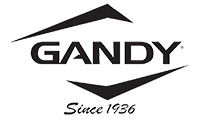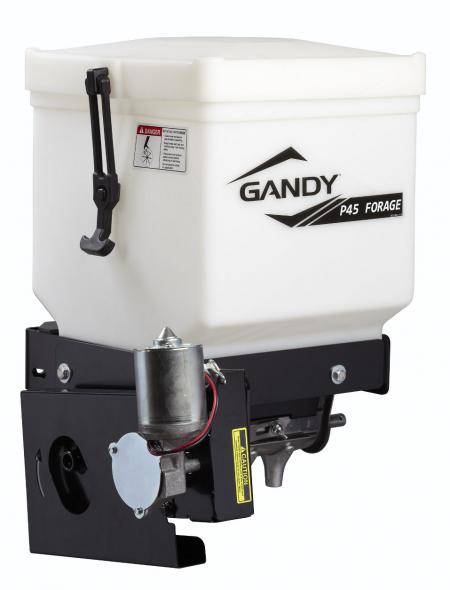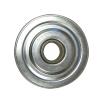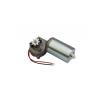45 Lb. Feed/Forage Additive Applicator with Two Outlet
45 lb. capacity applicator precisely delivers ingredients to preserve or fortify feedstuffs. Hopper is translucent allowing the operator to easily check on the remaining volume. Includes a two-outlet bolt on stainless steel bottom and slide with straight spouts and a precision cam gauge to regulate the openings in the bottom to apply the recommended rate for your individual operation. For internal agitation an 8" resilient rubber rotor bar comes standard driven by a 12-volt, 1/64 hp, 4 amp electric motor is included. A 25-ft. cord with an in-cab control switch. A U-frame bracket is included with 1/2" mounting holes and slots. Customer is responsible to provide specific mounting apparatus from particular implement to attach to the U-Frame. A hopper extension is available to add an additional 30 lbs. of capacity. For use with feeding systems, silage blowers, choppers, balers or similar systems.
45-lb. Capacity Poly Hopper
Features
- Translucent hopper allows operator to gauge volume in the hopper at a glance
- Hopper made with UV protection and anti-static properties
- Bolt-on stainless steel precision mated bottom and slide - removes for cleaning
- Precision cam-type gauge sets rates by using the stop as the gauge point and adjusts the openings in the applicator's bottom. When tightened, the cam gauge maintains postion whether slide is open or shut
- Porous, oil-impregnated bearings with weather-guard seals and bearing retainers
- 8-inch rubber rotor bar (5-bladed) supplies material to the hopper openings and restricts material flown when rotor stops
- U-frame bracket allows for surface mounting
- 12-volt, 4 amp electric (1/64 hp) motor drive assembled in place
- Hole closure caps and spring clips included to close-off unused outlet(s)
Options
Extension adds approximately 30 lbs., of capacity; 110-volt converter allows operator to plug unit into any 110-volt power source
Note: The Anertec & Gandy Company does not supply rate charts for additive or preservative products. Operator must consult the manufacturer of the product and complete a field calibration check prior to use
Dimensions
Where should an applicator be mounted on a large round baler?
Most feed additive manufacturers recommend the applicator should be mounted on balers so that the dry, granular inoculant is directed to the back of the pickup on large, round balers. (However, always be sure to check the manufacturer's instructions for proper placement.) You can use wire or metal support to help position hoses, but be sure not to "crimp" the hoses which would interfere with product flow.
Where should an applicator be mounted on a small, rectangular baler?
Most feed additive manufacturers recommend the applicators should be mounted on balers so that the dry, granular inoculant is directed in front of the plunger on small, rectangular balers. (However, always be sure to check the manufacturer's instructions for proper placement.) You can use wire or metal support to help position hoses, but be sure not to "crimp" the hoses which would interfere with product flow.
Can I leave material in the hopper overnight?
No. Empty the applicator and store the product in an air-tight container if material is not going to be dispensed immediately. Various materials can be hydroscopic and absorb moisture which can make the material bridge and not flow if left in the applicator for an extended period of time.
Why is a suspender placed above the rotor bar inside the hopper?
A removable "suspender" above the rubber rotor bar is standard equipment to reduce product weight on the rotor which reduces torque on the motor. It has aided flowability of many products. However, the suspender may be removed if necessary for some products.
Are rate charts available?
Unfortunately, due to the wide variations of product along with atmospheric conditions and product formulations, operator's need to calibrate the applicator prior to use each season.
How do you calibrate the applicator?
Calibrate the applicator to administer the recommended amount of inoculant per ton of baled hay. If unit has an electric motor drive, the easiest method to calibrate is to catch the material from the spouts for the length of time it normally takes to bale a ton of hay, i.e. 2 min, 5 min, etc.
Most balers will bale somewhere between 5 and 30 tons of hay per hour. It is difficult to predict exact values because of variables such as ground speed and windrow density. Under average conditions, it will require about 5-8 minutes to bale a ton of small, rectangular bales and 2-4 minutes to bale a ton of large, round bales.
Example for rate of 2 lb. /ton:
If it requires 6 minutes to bale a ton of hay, the applicator needs to meter out 1 lb. of inoculant every 3 minutes. A recommended starting point for calibrating a 2-hole cam gauge applicator is a dial setting of 10 for small, rectangular balers and dial setting 15 for large, round balers. A lower setting may be your starting point if you have a 3 or 4-outlet applicator or if your choice of forage additive is a higher concentration.
For best results, remember to:
1) Know the moisture of the hay and do not exceed 25% moisture for small, rectangular bales and 20% moisture for large, round bales.
2) Apply recommended rate of the dry granular inoculant per ton of hay (as baled moisture).
3) Store "tough" hay properly to permit escape of "extra" moisture contained in the bales.






